Sources For
Fiber Optic Transmitters - LEDs And Lasers
Most systems use a
"transceiver" which includes both transmission and
receiver in a single module. The transmitter takes an
electrical input and converts it to an optical output from
a laser diode or LED. The light from the transmitter is
coupled into the fiber with a connector and is transmitted
through the fiber optic cable plant. The light from the
end of the fiber is coupled to a receiver where a detector
converts the light into an electrical signal which is then
conditioned properly for use by the receiving equipment.
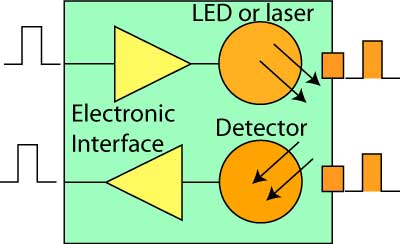
Fiber Optic
Transceiver
The source used for a fiber optic transmitter needs to
meet several criteria: it has to be at the correct
wavelength, be able to be modulated fast enough to
transmit data and be efficiently coupled into fiber.
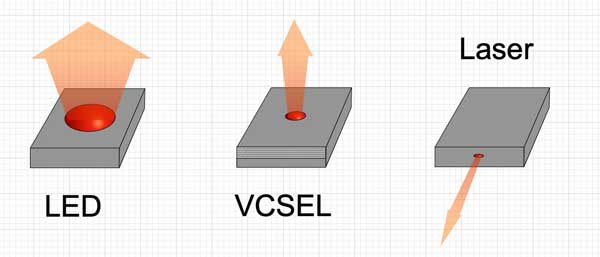
3
types of semiconductor lasers used as fiber optic
sources
The types of
sources used include LEDs, lasers, fabry-perot (F-P)
lasers, distributed feedback (DFB) lasers and vertical
cavity surface-emitting lasers (VCSELs). All convert
electrical signals into optical signals, but are
otherwise quite different devices. All three are tiny
semiconductor devices (chips) really the size of grains
of sand. LEDs and VCSELs are fabricated on semiconductor
wafers such that they emit light from the surface of the
chip, while f-p and DFB lasers emit from the side of the
chip from a laser cavity created in the middle of the
chip.
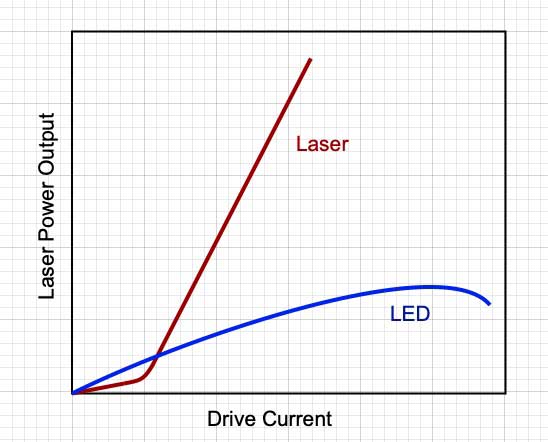
Light-current
(L-I) curves for LEDs and lasers
Lasers and LEDs
are quite different devices as you can see from this
diagram of their light output as a function of drive
current. LEDs are simple emitters that generate more
light output as the drive current increases until higher
currents heats them up and their ligh output decreases,
limiting the total power output. Lasers start off like
LEDs, generating more light with more drive current, but
the light is confined in a small areas in the
semiconductor chip called the laser cavity, horizontally
inside the chip for most lasers but vertically in a
VCSEL Like all lasers, once a certain amount of light is
generated inside the laser cavity, the device becomes a
"laser" - an acronym for "light amplification by
stimulated emission of radiation." Once the device
reaches a certain current level, it passes the laser
threshold and the light output becomes much higher with
little increase in current.
The L-I curves
help show why lasers have higher bandwidth than LEDs.
LEDs are modulated over higher current ranges to pulse
the light output on and off. Lasers are biased at the
threshold then modulated with small current changes to
get large changes in light output. The smaller size of
of lasers also makes them easier to modulate faster.
Generally LEDs are limited to several hundred
megabits/second links while lasers are good for 25-50
gigabits per second links when direct modulated. (Higher
bit rates are possible by having the laser on all the
time (CW) and modulating it externally.
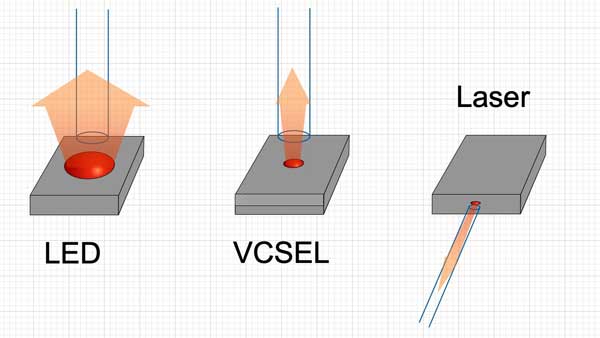
Coupling
power into the core of a fiber. Generally LEDs and VCSELs
are used with multimode fiber and lasers with singlemode
fiber.
LEDs have much
lower power outputs than lasers and their
larger, diverging light output beam pattern makes
them harder to couple into fibers, generally limiting
them to use with multimode fibers. LEDs
have much less bandwidth than lasers and are limited to
systems operating up to about 250 MHz or around 200
Mb/s.
Lasers have
smaller tighter light outputs and are easily coupled to
singlemode fibers, making them ideal for long distance
high speed links. Lasers have very high bandwidth
capability, most being useful to well over 10 GHz or 10
Gb/s.
VCSELs are a
strange device. They use semiconductor fabrication
tricks to create a vertical laser cavity in the chip so
the light comes out the top, making it easy to couple
into fiber. But the device structure has only been
feasible for ~850nm sources, the wavelength used for
multimode fiber.
Because of
their fabrication methods, LEDs and VCSELs are cheap to
make. Lasers are more expensive because creating the
laser cavity inside the device is more difficult, The
chip must be separated from the semiconductor wafer and
each end coated before the laser can even be tested to
see if its good.
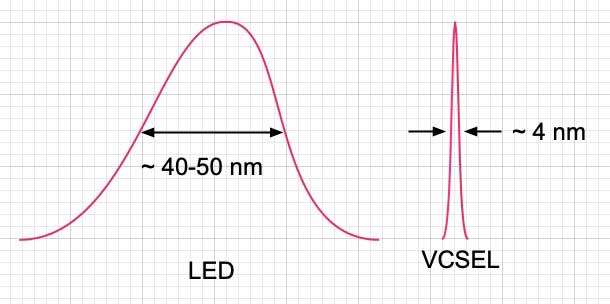
Comparison
of spectral output of a LED and a VCSEL, both with a
center wavelengh around 850nm.
Another big
difference between LEDs and both types of lasers is the
spectral output. LEDs have a very broad spectral output
which causes them to suffer chromatic dispersion in
fiber, while lasers have a narrow spectral output that
suffers very little chromatic dispersion. In multimode
fiber, the bandwidth of LEDs is highly limited by
chromatic dispersion because of its large spectral width
(light at longer wavelengths travels faster than light
at shorter wavelengths causing dispersion). This adds to
VCSELs advantage for higher speed networks.
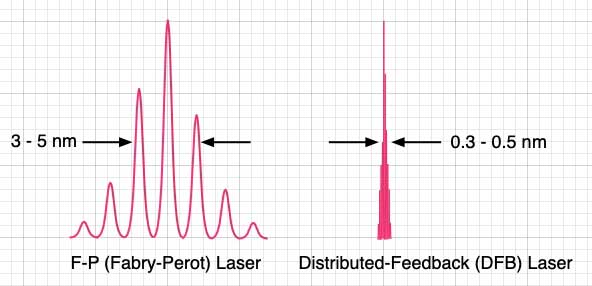
F-P
lasers have a variety of wavelengths, but DFB lasers are
generally in the range of 1490 to 1500nm wavelength
There is also a
big difference in F-P and DFB lasers. Modification of
the laser cavity in the chip can reduce the spectral
width of DFB lasers considerably. DFB lasers,
which are used in long distance and DWDM
systems, have the narrowest spectral width which allows
much denser wavelength division multiplexing with more
channels in a single fiber. The narrower spectral width
of DFB lasers minimizes chromatic dispersion for use on
the longest links.
DFB lasers are
also highly linear (that is the light output directly
follows the electrical input) so they can be used as
analog transmitter sources in AM CATV systems. In fact,
it was the invention of the DFB laser that made hybrid
fiber-coax CATV networks - and the subsequent invention
of the cable modem for broadband - possible.
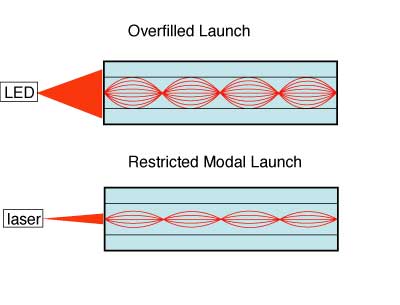
Differences in
multimode launches with LEDs and alsers
The choice of these devices is determined mainly by
application, speed, distance and fiber compatibility
issues. As many premises systems using multimode
fiber have exceeded bit rates of 1 Gb/s, lasers (mostly
VCSELs) have replaced LEDs. The output of the LED
is very broad but lasers are very focused, and the
sources will have very different modal fill in the
fibers. The restricted launch of the VCSEL (or any
laser) makes the effective bandwidth of the fiber
higher, but laser-optimized fiber, usually OM3 or OM4,
is the choice for lasers. OSP networks that are short
and not so high speed generally use 1310nm F-P lasers
while longer, faster links, especially those using DWDM
will use DFB lasers at ~1550nm.
Typical Fiber
Optic Source Specifications
| Device
Type |
Wavelength
(nm) |
Power
into
Fiber (dBm) |
Bandwidth |
Fiber
Types |
| LED |
850,
1300 |
-30 to -10 |
<250
MHz |
MM |
| Fabry-Perot
Laser |
850,
1310 (1280-1330) 1550 (1480-1650) |
0
to +10 |
>10
GHz |
MM,
SM |
| DFB
Laser |
1550
(1480-1650) |
0
to +25 |
>10
GHz |
SM |
| VCSEL |
850 |
-10
to 0 |
>10
GHz |
MM |
Note/Trivia: At
around 1300nm wavelength, LEDs are generally referred to
as 1300nm and lasers as 1310nm. LEDs, as you see above,
have broad spectral outputs so the wavelength is harder to
define precisely. LEDs vary trom ~1270 to 1330nm. Lasers
have always been called 1310nm because that is what
AT&T called them in the early 80s when they first
started making them commercially. In fact lasers vary from
~1280-1330nm. This has also become the reason that
multimode systems, which were mostly LEDs until VCSELs
were invented, are called 1300nm and singlemode systems
which always used lasers were called 1310nm.
Table
of Contents: The FOA Reference Guide To Fiber Optics

